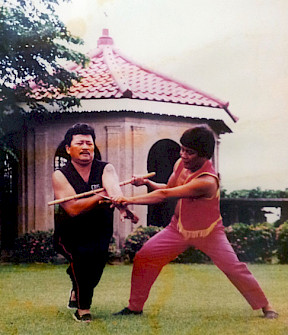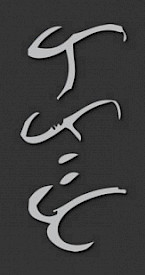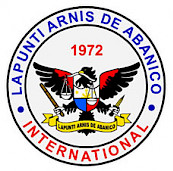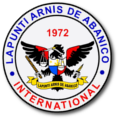What is Lapunti?

Lapunti Arnis De Abanico, otherwise referred to simply as ‘Lapunti’, is a Filipino martial art that originated from Cebu, Philippines. It is a comprehensive and unified martial art system that includes training in the use of impact and bladed weapons which can be translated to the use of common everyday objects and eventually empty hand. Training in Lapunti allows practitioners to develop a set of valuable skills and mindset which can be applied not only in combat or self-defense scenarios, but also in everday life by instilling values that would improve one's character or disposition.
Among the Filipino martial arts, Lapunti is considered unique, or peculiar, based on two of its most notable characteristics:
- Its use or emphasis on fast abanico strikes, and
- Its use of the cross-legged stance and footwork
Abanico (or fan) strikes goes around common blocks or positions of defense; and the abanico style of eskrima employs combinations that strikes the opponent in rapid succession and at often unexpected angles. Lapunti’s abanico style was honed and developed through decades of experimentation and actual use in combat or sparring matches. Though other styles of eskrima also includes abanico in their repertoire, they often do so sparingly and in a manner characteristic of their own style, which could be considered different from Lapunti.
Lapunti is also the only style of arnis or eskrima that makes use of ‘cross-legging’, or the cross-legged stance and footwork. It has been compared by some to tai-sabaki (evasive body shifting) of Japanese martial arts, but its real roots are in Kung Fu, particularly the cross-legged footwork of Choy Lee Fut. Grand Master Johnny Chiuten—a Filipino-Chinese Kung Fu master and a legend in his own right in early Philippine martial art circles—is credited for incorporating cross-legging, as well as a variety of locks and takedowns, into Lapunti. This style of footwork was further developed by Lapunti’s present Supreme Grand Master, Undo Caburnay, into the form now uniquely identified with Lapunti.

Like the abanico strikes of Lapunti, cross-legging could be difficult to learn at first. But once mastered it affords the practitioner with a means for great mobility. Properly used, cross-legging enables Lapunti practitioners to:
- swiftly close the gap, or create distance, between them and their opponent (fast advance and retreat),
- gain a position of advantage while maintaining distance (sidestepping or angling),
- effectively deal with multiple opponents (swiftly rotating in place to face any direction), or
- move effectively in tight or confined spaces (using torque, or tight twisting motion, to evade attacks, or to generate force for blocks and strikes)
There are other forms of footwork and offensive/defensive techniques in Lapunti, but cross-legging and abanico strikes forms a major part of what makes Lapunti stand out, or different, from other styles. When used together, Lapunti’s strikes and footwork forms a potent combination that could bring crucial advantage in an actual combat or self-defense situation.
What's in a name?

‘Lapunti’ is a combination of the names of the three barangays in Cebu where Lapunti’s founders, The Caburnays, lived and developed the style–these are the barangays of Labangon (La), Punta Princesa (Pun), and Tisa (Ti). The present Supreme Grand Master of the system, Prudencio ‘Undo’ Caburnay, is also a public servant (councilor) in Tisa and have been so for many years now.
‘Arnis’ is a generic term for any of the Filipino martial arts employing the stick as a primary weapon or training tool (often as a replacement for bladed weapons), otherwise referred to as ‘eskrima’.
‘Abanico’ means ‘fan’, otherwise referred to in Filipino as ‘pamaypay’. The term ‘Arnis De Abanico’ means ‘Fan Style of Arnis’, and refers to the distinctive fan-like way of using the weapon or stick which gave the style its name.
LAPUNTI also serves as an acronym for the ideals or values that should be pursued by every practitioner of the art. These are:
- Love,
- Artistry,
- Philosophy,
- Unity,
- Nimbleness,
- Truthfulness, and
- Integrity
The Lapunti Logo

The official Lapunti logo has at its center a Philippine Eagle depicted in black and red, the colors of Lapunti, and holding a garote (or stick) in its right claw and a daga (or dagger) in its left claw. The Philippine Eagle (Pithecophaga jefferyi), as its name suggests, is the national bird of the Philippines, otherwise known as the Monkey-eating Eagle. The stick and dagger are the traditional weapons used in a style of fighting called espada y daga, which is taught in the advanced levels of Lapunti and which Lapunti is also renowned for. The eagle is also depicted as holding a weighing scale in its beak, representing justice, fairness, or balance; and with the Philippine shield or coat of arms on its breast.
Above the eagle is the year when Lapunti was officially founded; and below it is a ribbon with the name of the style or system, ‘Lapunti Arnis De Abanico’. At the circumference are the words ‘Lapunti Arnis De Abanico International’, the official name of the organization.
History of Lapunti Arnis De Abanico
|
Early 1900s |
Arsenio ‘Seniong’ Caburnay (born: Circa 1882, died: 1962) traveled throughout the provinces of Visayas, Negros, Bohol, Leyte, Samar, and the cities of Cagayan De Oro, Illigan, and Ozamis in Mindanao, plying his trade as a ‘panday’ or blacksmith. Seniong was known especially for the quality bolos that he produced, an implement used both for farming and sometimes for self-defense. His interest in martial arts in general also led him to learn from the many people that he visited. |
|
1927 onwards |
Seniong’s younger brother, Felimon Caburnay (born: 1915, died: 1992), started learning the trade of blacksmithing at the age of twelve, and accompanied his older brother throughout the Visayas and Mindanao. He also began learning different styles of arnis or eskrima both from Seniong and the people that they met. |
|
Before 1941 |
Prior to the Japanese occupation of World War 2, the Caburnay brothers practiced and honed their martial art skills with a small group of friends at their base in Southern Cebu. Seniong and Felimon became part of a group of martial artists that included Juan Abella, Antonio Alingasan, Concordio Encabo, Ramon Fernandez, and Lauriano Sanchez. This small circle of friends practiced and shared their martial art styles among themselves, later unifying it into one style and calling it ‘Arnis De Abanico’ (Fan Style of Arnis). |
|
1957 onwards |
Master Felimon Caburnay was invited to the Doce Pares Club to teach the Abanico style and became a close friend and sparring partner of Master Felimon Cañete. The two Felimons constantly practiced together, becoming both renowned for their extraordinary skills in espada y daga (stick/sword and dagger). Some accounts even say that during his stay as a member of Doce Pares, Master Felimon Caburnay accepted all challenges for the club from other clubs and bested his opponents using his abanico style. Master Felimon Caburnay later separated himself from the Doce Pares Club due to frustrations with the club’s restrictions, especially relating to tournaments and tournament rules. Free from Doce Pares’ confinements he decided to teach his style openly, under the old name of ‘Arnis De Abanico’. |
|
1960 |
Prudencio “Undo” Caburnay (born: April 28, 1942), son of GM Felimon Caburnay and current Supreme Grand Master of the style, began training in the Arnis De Abanico circle. It was also during the 60s when Undo Caburnay began to research and develop his own style within the Arnis De Abanico group—incorporating all that he learned from his father, uncle, and friends, and modifying the movements and techniques to best suit his small stature. |
|
1962 |
GM Seniong Caburnay died, leaving his brother and nephew to continue developing the family style. |
|
Circa 1970 |
Grandmaster Johnny Chiuten (born: (?), died: 2010) sought out and collaborated with Grand Master Felimon Caburnay to incorporate elements of Kung Fu into the style. GM Johnny Chiuten was a consumate martial artist and master of different Japanese, Chinese, and Filipino martial art styles. He was also a master of the Balintawak style of eskrima, trained in the advanced levels by the style’s founder, Anciong Bacon. GM Chiuten became frustrated with his old eskrima club and separated himself from the group. He later sought out GM Filemon Caburnay through one of his senior students (who was, previously unbeknownst to him, also a student of GM Felimon Caburnay). Grandmaster Chiuten was so impressed by the principles of the abanico style (according to accounts, it was the only style of eskrima he encountered that employs strikes which he wasn’t able to block or anticipate, much less apply disarming techniques to) and by Grandmaster Felimon himself, that he asked the elder Grandmaster to teach him the style. In return, he offered to further improve or refine the style by incorporating some of the footwork, stances, locks and takedowns from Shaolin Kung Fu, most of which he learned from the legendary master, Lau Kim. GM Felimon agreed and thus began the collaboration between the two Grandmasters. It was also around this time when GM Felimon Caburnay together with his son, Undo Caburnay, began incorpoarating evasion techniques, locks, and takedowns that they learned from other masters in what was to become the modern form of the style. |
|
December 30, 1972 |
GM Filemon and his son, Master Undo Caburnay, officially founded the new school and called it ‘Lapunti Arnis De Abanico’, after the names of the place and surrounding areas where the art was developed. |
|
1987 |
The organization tasked to oversee the affairs and promotion of the style was established, and officially named Lapunti Arnis De Abanico International (LADAI). |
|
1992 |
With the death of GM Felimon Caburnay, Undo Caburnay inherited the title of Grand Master of Lapunti Arnis De Abanico, both by virtue of family lineage and fighting skill. Ever the innovator, GM Undo continued to teach and refine the system ever since. He now holds the honorary distinction and rank of Supreme Grandmaster of Lapunti. |
SOURCES:
- Lapunti Arnis/Escrima (visayanmartialarts.com article)
- Eskrimadors (A Filipino Martial Arts Documentary)
- Interviews with SGM Ondo Caburnay and senior Lapunti practitioners
- Interview with Sifu Vince Borromeo, Choy Lee Fut instructor and a senior student of GM Johnny Chiuten
- Johnny Chiuten – Profile of a True Grandmaster
- Lapunti Arnis de Abanico (black-eagle.org article)
